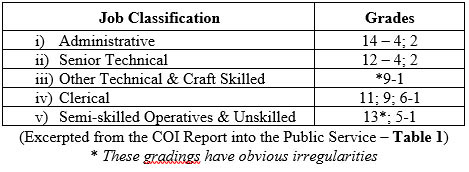Dear Editor,
One wonders how many of political and relevant pontificates have bothered to research when the current Public Service Job Structure was established, with a related compensation structure.
According to paragraph 168 of the 2016 Report of the Commission of Inquiry into the Public Service it was between 1991/1992 that an intervention by Consultants Peat Marwick McLintock facilitated the reduction of an initial sixteen (16) Grade Job Structure to the current fourteen Grades. The latter are still distributed as follows:
Incidentally the Teaching profession’s twenty-one (21) Grade Job Structure has been in existence since colonial days. Teachers appear to be satisfied however with this patent anachronism – so obviously overdue for reformation.
In the current pandemic rush to replace Regional Executive Officers, Heads of Departments, Permanent Secretaries, and other categories of Public Service/Sector employees, the Administration has ignored its own pronouncement by its Minister of Public Service in 2002, which included the following, amongst others:
“It must be recognised that a radically different way of doing things in the public service must be adopted….There must be a new management style of getting results.”
Amongst the five cornerstones recommended by the Minister on which to modernise Guyana’s Public Sector Management were the following:
(a) Build performance management and evaluation structure;
(b) Establish a new human resources management structure.
The aforementioned COI did in fact retain the 14 Job/Grade Structure but in the form of the following classification:
The above implies the need for a major Job Evaluation exercise.
Recommendation #47 of the COI Report specifies the need to:
– Describe
– Evaluate; and
– Place jobs in (new) Structure
Of course the substantive operational and developmental changes demanded of the current/post-pandemic work environment would have brought a more immediate perspective to such Human Resources issues as:
– Job Descriptions
– Job Evaluation
– Performance Evaluation
It is in this context therefore that, given the continuing new and changing technological requirements, and the related new/revised specifications (professional, craft and even clerical), priority has to be given to the transformation of the role of ‘Personnel Officer’ to the more dynamic function of Human Resources Management – incurring in the process comprehensive training and developmental programmes.
According to the 2019 Budget ‘Personnel Officers’ are graded as follows:
The requirement for a very focused Performance Evaluation Programme becomes more urgent when one observes the gaps amongst Grades 6 and 11.
Of concern is the fact that Human Resources functionaries are normally expected to be proactive coordinators of the education, training and human developmental functions of organisations.
In the circumstances one keeps looking forward to how the socio-economic transformation envisaged will be informed by the necessary reformation of the public human resources management capacity – in order to achieve compatibility with systems and processes understood by new (foreign) employers, with whom it will be necessary to negotiate.
Yours faithfully,
E.B. John
Consultant
Human Resources Management & Development







